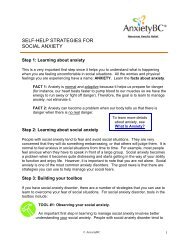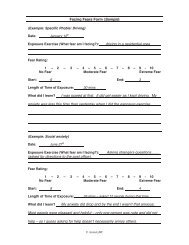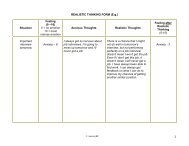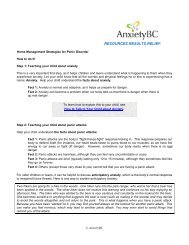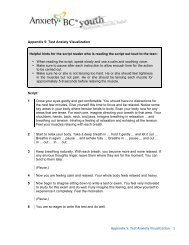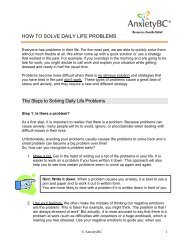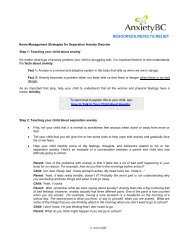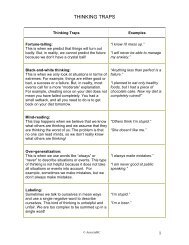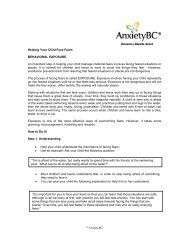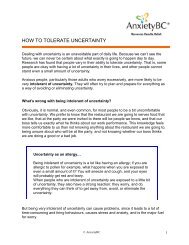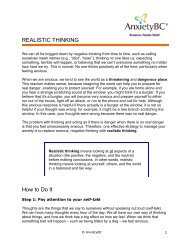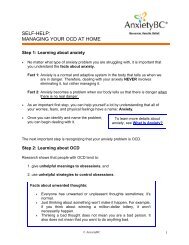Home Management Strategies for OCD - Anxiety BC
Home Management Strategies for OCD - Anxiety BC
Home Management Strategies for OCD - Anxiety BC
You also want an ePaper? Increase the reach of your titles
YUMPU automatically turns print PDFs into web optimized ePapers that Google loves.
Praise, Praise, Praise!!<br />
Because it is hard work to manage <strong>OCD</strong>, your child needs lots of<br />
encouragement. Some helpful rewards can be:<br />
Tool #3: Addressing Reassurance-Seeking<br />
Stickers that your child can put on a posterboard every time he or she<br />
tries to boss back <strong>OCD</strong><br />
Verbal praise: “What a great job you are doing!”; “I’m so proud of you!”;<br />
“Look how brave you are!”<br />
Rewards at home: extra TV time, family time together, playing a fun<br />
board game, dinner at a favourite restaurant, or a new toy. Some<br />
rewards should be more long-term. For example, “When you are able to<br />
boss back the <strong>OCD</strong> <strong>for</strong> a whole day and not check any doors, we will go<br />
to the toy store and get a new video game <strong>for</strong> you.”<br />
Because children with <strong>OCD</strong> often want reassurance from their parents, this is an important tool,<br />
not only <strong>for</strong> your child, but also <strong>for</strong> you.<br />
When your child asks <strong>for</strong> reassurance, <strong>for</strong> example, “are you sure the kitchen is clean?”, you can<br />
answer in the following ways:<br />
o “What if it’s not completely clean? What would happen then?”<br />
o If your child gets very anxious, you can remind him or her that <strong>OCD</strong> is being a bully, and<br />
ask which tool he or she can use from the <strong>OCD</strong> toolbox.<br />
o You can give your child reassurance once, and then if he or she asks again, you can<br />
reply: “I already answered that question. Why don’t you try using your toolbox?”<br />
To learn how to explain this to your child, see<br />
How to Address Excessive Reassurance Seeking .<br />
Tool #4: Facing Fears: Exposure and Response Prevention<br />
The majority of the work in helping your child or teen “boss back” the <strong>OCD</strong> is in helping your child to<br />
gradually face his or her fears. This involves developing a list of all of your child’s rituals (e.g., washing<br />
hands, checking doors), as well as a list of situations when your child completes the rituals (e.g., when<br />
touching the doorknob or when going to bed at night). With <strong>OCD</strong>, this is sometimes called “Exposure and<br />
Response Prevention,” because children or teens need to face their fears (e.g., touching the doorknob),<br />
and then deliberately not do their compulsion (e.g., washing hands). Facing fears is the exposure part;<br />
not doing the compulsion is called “response prevention.” Gradually, your child can begin reducing these<br />
behaviors by not doing the compulsions and then tolerating the anxiety until it subsides. This tool will<br />
probably be the most effective of all the <strong>OCD</strong> tools.<br />
© <strong>Anxiety</strong><strong>BC</strong><br />
3



